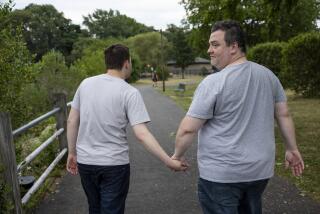Unproven but Attractive Magnet Therapy
- Share via
After minor surgery on her right hand, Linda Jane Evans felt debilitating pains she never expected, pains so severe she could not drive a car, hold a coffee cup, fasten a button, even turn the pages of a book.
When traditional physical therapy failed, the attorney turned to acupuncture. She slowly regained use of her hand but still felt hampered by pain and stiffness.
William Loeliger, medical director of the alternative health center at Greater Baltimore Medical Center, suggested Evans try using a magnet. So last summer, Evans taped a flat magnetic disc over the acupuncture point at her wrist for one to two hours a day.
“The achiness would go away and my wrist would feel a little more limber,” she says. “It was helping the healing.”
Now, the Baltimore resident says she hardly ever wears an arm brace. Although she credits her recovery to the combination of acupuncture and magnet therapy, she keeps a magnet on her bedside table, ready to use if pain returns.
Like thousands of Americans, Evans has become a believer in the power of magnets to speed recovery for conditions ranging from tendinitis and back pain to migraine headaches and fibromyalgia, a neuromuscular condition of unknown cause.
Touted widely by professional athletes, especially golfers, “therapeutic” magnets are popularly celebrated as a noninvasive, no-side-effects remedy. Available from department stores, alternative health centers and marketing companies, magnets are sold individually or in insoles, mattress pads, pillows, hairbrushes, jewelry, even cosmetics.
But the American Medical Assn., the Food and Drug Administration and the National Council for Reliable Health Information caution that there is not enough proof to claim that magnet therapy actually works.
So far, small studies have shown magnets to be effective in reducing pain in post-polio patients and diabetics. A 1997 peer-reviewed study by Dr. Carlos Vallbona at Houston’s Baylor College of Medicine found a 75% success rate in a study of 50 post-polio syndrome patients who applied low-intensity magnets to areas where they felt arthritis and muscle pain.
In another study, published last year in the American Journal of Pain Management, New York neurologist Michael Weintraub reported that 24 patients found that magnetic footpad insoles relieved chronic foot pain caused by diabetes and other ailments.
*
The National Institutes of Health’s Office of Alternative Medicine is awaiting two reports on magnet therapy from centers it supports. One study, concerning the ability of magnet mattress pads to reduce the pain of fibromyalgia, is expected later this year from the Center for the Study of Complementary and Alternative Therapies at the University of Virginia’s School of Nursing. Another, examining the role of magnets in preventing strokes, is under way at the Kessler Rehabilitation Center in West Orange, N.J.
“The problem with magnets right now is that all of this work is extremely preliminary,” Loeliger says. “It’s almost the interest of the public that is driving this, rather than the interest of medical professionals.”
Dr. John Renner, president of the National Council for Reliable Health Information, worries that consumers might use magnets as a substitute for seeing a physician and that fuzzy logic about magnetic fields prevails. He’s also uncomfortable with studies aimed at treating pain.
“Pain is such a subjective measurement,” he says. “And an awful lot of alternative medicine offerings are aimed at pain.”
*
Magnet therapy generally requires applying small, powerful magnets to painful areas. Even those who believe in it are not sure exactly how it works.
Some researchers speculate that the magnets affect pain receptors in the joints, muscles or brain. Others believe they stimulate acupuncture points. Many say they promote healing by stimulating blood flow to the affected region, which brings extra oxygen and nutrients and reduces inflammation as toxins are flushed out.
“I think there is a therapeutic benefit to magnets, even though I don’t understand how they work,” says Loeliger, who was trained as an anesthesiologist and practices magnet therapy in conjunction with acupuncture. “After a couple of years, when everyone has heard of magnets, we will begin to sort out what their true usefulness is.”
Meanwhile, companies selling magnet products must be careful not to make medical claims. Still, magnet sales, expected to surpass $500 million this year, demonstrate that people are willing to try them.
Magnet therapy intrigues some physicians because it is noninvasive, appears to be nontoxic and has none of the side effects of commonly prescribed pain medications.
Physicians who use magnetic therapy caution that people should never use magnets without getting a medical diagnosis for a health problem. And they say it is probably safer for pregnant women not to use them, and people with pacemakers should not use them near their implants.
*
Because magnets appear to increase blood flow to an injured area, Loeliger adds that people should not use magnets within 24 hours of an acute injury--or in any other situation in which additional blood flow would be harmful.
Loeliger says he has used magnets successfully--but discriminately--to treat chronic tennis elbow, migraines, fibromyalgia and back pain.
“I treat magnets like medicine: Use one for a short period of time and when the condition you’re treating is healed, you take it off.”






